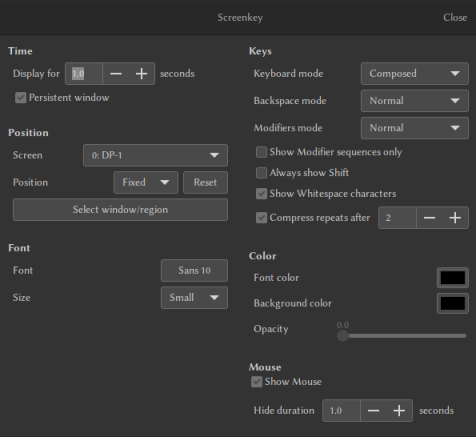Linux
- [default browser](#set-default-browser)
- [time](#set-time)
- [hover click](#hover-click)
- [transparency](#transparency)
- [greyscale](#greyscale)
- [settings](#screenkey-settings)
- [XRaiseWindow](#xraisewindow)
- [xkbset](#xkbset)
- [sticky keys](#xkbset-sticky-keys)
- [xclock](#xclock)
</div>
set
$BROWSER
export BROWSER="/usr/bin/browser"
Some programs that are graphical, are under no obligation to use the $BROWSER variable
Write your own desktop entry
xdg-mime default browser.desktop x-scheme-handler/http
xdg-mime default browser.desktop x-scheme-handler/https
time
ntpd -qg
hwclock -w
ntpdate pool.ntp.org
gammastep
gammastep -l 31.4:64.1 -t 5700:3600 -g 0.8 -m randr -v
mousetweaks
hover click
setsid mousetweaks --dwell --dwell-time=0.3 --threshold=10
Picom
picom
transparency
These are my personal configs
greyscale
Create file.gsl
Start picom by including the .gsl file path
picom --backend glx --window-shader-fg /path/to/shader/file.gls
screenkey
settings
Run screenkey --show-settings
Below is an example 'config' that I use

xorg
xraisewindow
In some xorg window managers, users have reported wmctrl not working out of the box. Since we are already using the x11/xlib library for our respective window managers, we can write a c++ program (see above for original author), to raise windows. We then call this with a simple shell script and map this to a keypress.
To compile run c++ totop.cpp -L/usr/X11R6/lib -lX11 -o totop
We have named this program 'totop' as in to the top of the window stack
The shell script, id=$(xwininfo -name "st" | grep id: | awk "{ print \$4 }") && totop $id
Alternatively you can ommit the second line, and only use the third with the id if you know it
xkbset
sticky keys
xkbset sticky -twokey -latchlock
To achieve "hold down shift" remove the "-" from -latchlock
xclock
xclock -digital -strftime "%%H:%%M"